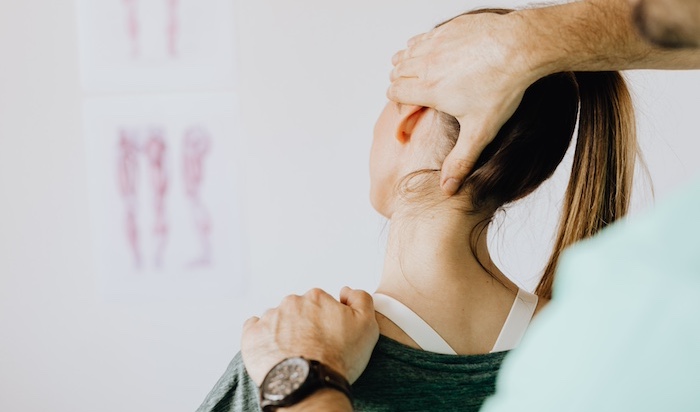
If the patient cannot relax or simply dislikes the cavitation/cracking feeling or sound or any concern, a gentle form of chiropractic adjustment may be utilized rather than the more traditional techniques. Some of these methods include a slower (low-velocity) technique performed within the passive range of joint motion.
Common Gentle Chiropractic Techniques
Examples of commonly employed gentle chiropractic techniques include (but are not limited to):
- Cervical mobilization: The patient is usually lying on his or her back and is relaxed while the chiropractor manually moves the vertebra in the neck left to right, and vice versa, alternating between the side-to-side motion and a figure 8 movement, applied at varying degrees of moving the head forward, backward, and to the side and in rotation. This is a smooth, non-thrust type of stretch, to reduce fixations or areas where motion is restricted between the cervical spinal segments. An oscillatory movement with the hands is also frequently utilized during cervical spine mobilization.
- Cervical manual traction: The patient is usually lying face up or sitting, or less commonly prone (lying face down, on the stomach). The chiropractor gently pulls on the neck, stretching the cervical spine often varying the angle between flexion (forward) and extension (backward), based on comfort and searching for the correct angle to most efficiently reduce the tightness. This technique is often combined with mobilization, switching between the two and/or doing both simultaneously.
- Cervical "drop" techniques: The patient is either prone (lying on the stomach) or side-lying on a special type of table where the head drop-piece is lifted into a "set" or locked position. The chiropractor then places his or her hand and finger over the spinal segment requiring the adjustment. A medium to high velocity, low amplitude thrust, or, a non-thrust gradually increasing downward pressure is applied until the drop section/headpiece of the table releases and drops a short distance. The goal is to reduce the fixation or restricted motion of the cervical vertebra assisted by the special table. There is usually no rotation or twisting of the head/neck often utilized in the traditional chiropractic adjustment and the typical "crack" (joint cavitation) may or may not occur with this method.
Gentle Chiropractic Mobilization vs. Adjustment
Gentle chiropractic techniques typically do not involve rapid (high-velocity) rotation or side bending of the head and neck but rather a smooth, slow stretch (low-velocity, low amplitude).
There are several reasons a chiropractor may recommend gentle chiropractic techniques over a traditional high-velocity, low-amplitude adjustment, such as:
- Patient preference: Some patients do not feel comfortable with the traditional high-velocity thrust manipulation and prefer an approach that does not involve twisting their neck or joint "popping."
- Provider experience: Some chiropractors may favor one technique over another or several types of techniques that they have gained experience and skills with. Most chiropractors utilize several approaches and often modify and adapt several techniques to the patient’s needs and preferences.
- Contraindications: Some patients may not be able to tolerate the traditional chiropractic adjustment sometimes based on experience. In some cases where prior injury has resulted in certain types of spinal instability or, in cases of severe osteoporosis, cervical manipulation may not be appropriate. Other conditions include:
- In some cases of recent or acute trauma
- During the acute inflammatory phase of certain conditions, such as arthropathy, spondyloarthropathy
- When spinal instability is suspected, as is sometimes found in cases of Down's Syndrome
- Over tumor or metastasis (cancer)
- Cauda equina-like syndrome (cervical cord compression)
- Spinal infections (such as osteomyelitis)
- Acute myelopathy
- Acute, unstable fractures
It is common for a combination of methods to be utilized, in addition to adjunctive therapy such as exercise and heat/cold therapies, for chiropractic management of cervical spine pain.
Precision Pain Care and Rehabilitation has two convenient locations in Richmond Hill – Queens, and New Hyde Park – Long Island. Call the Queens office at (718) 215-1888 or (516) 419-4480 for the Long Island office to arrange an appointment with our Interventional Pain Management Specialists, Dr. Jeffrey Chacko or Dr. Sonny Ahluwalia.













